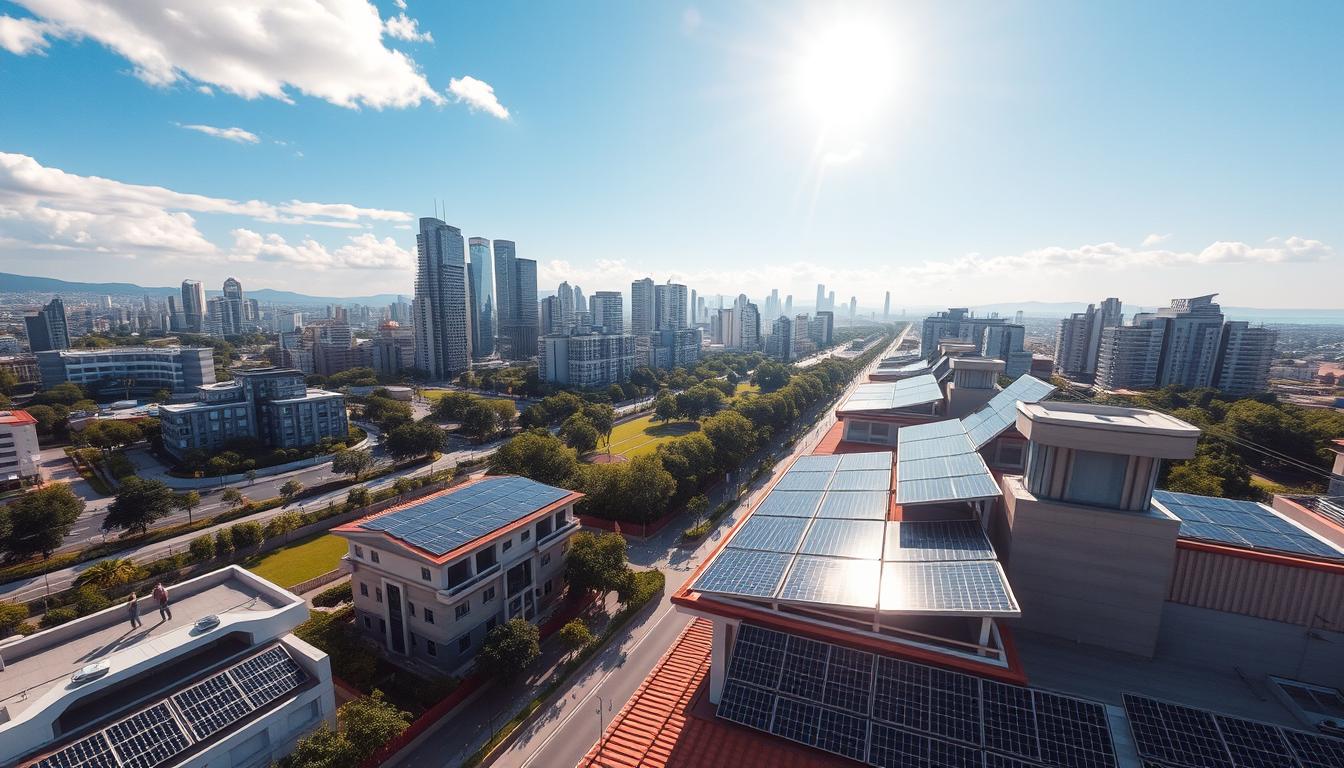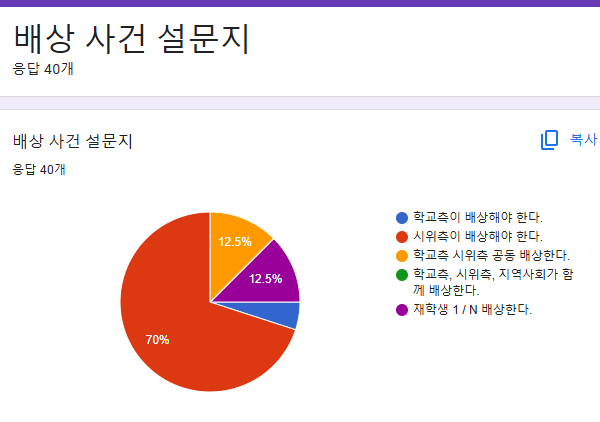“The sun, the moon, and the stars would have disappeared long ago… had they happened to be within the reach of predatory human hands.” – Henry David Thoreau’s words remind us of our duty to use solar energy wisely. As we face the global energy crisis, solar energy offers hope for a greener, more reliable power future.
The need for sustainable energy has never been more urgent. Solar energy is at the forefront, thanks to its endless, clean, and renewable nature. This article will look into the future of solar energy. We’ll explore new technologies, ways to connect solar to the grid, and research that’s changing the game. By tapping into the sun’s power, we can create a brighter, more sustainable energy future.
Key Takeaways
- The global energy crisis has made sustainable energy more crucial, with solar energy leading the way.
- Solar energy is a clean, endless, and renewable power source that can solve our energy problems.
- New technologies, grid connections, and research are fueling the renewable energy revolution.
- Using the sun’s power can lead to a more resilient and sustainable energy future.
- This article will dive into the future of solar energy and its role in creating a cleaner, more efficient energy world.
Harnessing the Power of the Sun
Understanding Solar Radiation and Its Potential
The sun’s energy is vast, enough to power the world for a year in just an hour and a half. Solar technologies like PV panels and CSP systems turn this energy into electricity and heat. Knowing how solar radiation works is key to a sustainable future.
| Key Solar Energy Statistics | Achievements |
|---|---|
| The Environmental Research Aircraft and Sensor Technology (ERAST) Alliance was created in 1994 and operated for 9 years with 28 members. | Pathfinder set a new altitude record for solar-powered aircraft, reaching an altitude of 50,500 feet on September 11, 1995. |
| SunPower’s A-300 cells offer up to 50% more power than conventional solar cells. | Helios achieved an altitude of over 96,000 feet for more than 40 minutes in 2001. |
| SunPower’s A-300 cells are at least 20% efficient in ground applications, up to 50% better than older technology. | The Dryden solar power demonstration site produces up to 5 kilowatts of direct current power on a sunny day. |
UNC scientists have created a system that turns sunlight into hydrogen fuel. This fuel can power devices even after the sun goes down. The system uses ultra-thin titanium dioxide layers to speed up the process.
This system, called a dye-sensitized photoelectrosynthesis cell (DSPEC), splits water into hydrogen and oxygen. It uses the sun’s energy to do this. This is a big step towards using solar power more efficiently.
“In one hour, the sun generates enough energy to power every vehicle, factory, and device on the planet for an entire year.”
The next goal is to use this system to make carbon-based fuels like formate or methanol. This could help reduce greenhouse gas emissions. This research shows the huge potential of solar energy.
Photovoltaic Marvels: Turning Sunlight into Electricity
Photovoltaic (PV) technologies are at the core of the solar energy revolution. They use the sun’s power to create clean, renewable electricity. Solar panels, made of photovoltaic cells, catch sunlight and turn it into direct current (DC) electricity.
These PV cells are thin semiconductor wafers that capture sunlight’s energy. They convert it into power we can use. Then, inverters change the electricity into alternating current (AC) for our homes and businesses.
Photovoltaic technology is key to distributed generation and a green future. As solar panels get better and cheaper, more people are using them. This change is powering our homes, businesses, and communities in a new way.
PV systems work for everyone, from small homes to big solar farms. Thanks to net metering, people can even sell extra electricity. This makes solar power more affordable and popular, helping our energy landscape grow greener.
“Solar energy is the future, and it is happening now. Every country in the world should be making the effort to utilize this renewable resource.”
Concentrating Solar-Thermal Power: A Mighty Alternative
Concentrating solar-thermal power (CSP) is another key solar energy technology. It uses mirrors to focus sunlight onto receivers. This process converts sunlight into heat, which can power turbines to make electricity.
This heat can also be stored for later use. This makes CSP a reliable and flexible source of renewable power. It’s especially good for large-scale, utility-level solar energy generation in sunny areas.
The parabolic dish concentration (PDC) system is very efficient, with up to 44% thermal efficiency. PDC systems can power turbines and also provide thermal energy. This energy is great for desalination, solar cooking, and water heating.
PDC’s versatility and high concentration power make it a strong solar thermal technology for many energy needs.
“Solar energy can provide about 3.85 million EJ of solar energy annually, which can cover individual energy needs in various fields in the coming years.”
But CSP systems have challenges too. They need advanced tracking systems and can lose heat. Yet, research and development in thermal energy storage and system integration can help. This could unlock CSP’s full potential as a reliable and sustainable power solution.
In the face of the energy crisis, concentrating solar-thermal power stands out as a strong alternative. It offers scalable, flexible, and efficient renewable energy generation. By using the sun’s power and improving solar thermal technology, CSP can be key in moving towards a sustainable energy future.
Solar Energy Integration: Seamless Merging with the Grid
Solar energy is becoming a big part of our energy mix. It’s important to integrate it well with the electrical grid. Rooftop solar and community projects are changing the grid, making it more resilient.
Distributed Energy Resources and Microgrids
Distributed Energy Resources (DERs) and microgrids are changing the energy scene. They generate power locally and make the grid more flexible. This improves the grid’s reliability and resilience.
Inverters and Grid Services
Inverters are key in making solar energy work with the grid. They turn solar DC into AC, which the grid uses. They also help control the grid’s voltage and frequency, making it more stable and efficient.
Energy Storage Solutions
Energy storage solutions, like batteries, help with solar energy’s ups and downs. They make it easier to use solar power in the grid. This helps balance power needs and makes solar energy more valuable.
Dealing with these challenges is crucial. It helps solar energy reach its full potential. This makes the power grid more sustainable, resilient, and efficient.
| Key Integration Aspects | Benefits |
|---|---|
| Distributed Energy Resources (DERs) and Microgrids | Improved grid resilience, local renewable power generation, and enhanced flexibility |
| Inverters and Grid Services | Conversion of solar DC to grid-compatible AC, and provision of valuable grid services |
| Energy Storage Solutions | Addressing intermittency, balancing generation and demand, and enabling greater solar integration |
“The future of the power grid lies in the seamless integration of distributed, renewable energy sources, enabled by innovative technologies and systems-level thinking.”
Solar Energy: Reducing Soft Costs for Affordability
The cost of solar energy systems has gone down. But, the “soft” costs like permits, loans, and getting customers still make up a big part of the total cost. In the U.S., soft costs are more than half of what it costs to go solar.
Lowering these soft costs is key to making solar energy cheaper and more accessible. This is especially true for homes and community projects. To tackle these costs, we’re looking at faster admin processes, new loan options, and solar projects in communities. These efforts aim to remove barriers and spread clean energy.
Solar companies face high costs due to slow processes. Governments new to solar also struggle with high costs in permits and inspections. But, new software can help solar companies save money. It makes things like finding customers and managing projects easier.
| Soft Cost Category | Reduction Potential |
|---|---|
| Permitting | Up to $1.00 per watt |
| Remote System Design | Up to $0.17 per watt |
| Residential Solar on New Construction | Considerable cost savings compared to traditional retrofit installations |
To make solar energy more affordable, we’re looking at new financing options and community solar. Community solar lets many people share one solar system. This makes solar energy cheaper for low-income families. Also, teaching professionals about solar can help speed up installations and lower costs.
By cutting down on soft costs and making solar energy more accessible, we can bring clean energy to more homes and communities in the U.S.
Solar Energy: A Pathway to Sustainability
Solar energy is more than just clean electricity. It’s leading us to a sustainable future. It empowers people, communities, and workers to join the renewable energy shift. From homes to community projects, solar is building energy resilience and tackling social issues.
Residential and Community Solar Initiatives
People and communities are embracing solar power. Homeowners can install solar panels, cutting down on carbon and bills. Community solar lets many share one big solar array, making green energy available to all.
These efforts change the energy scene. They boost energy freedom and environmental care in local areas.
Solar Workforce Development
The solar industry is growing fast, needing a skilled, diverse team. Solar workforce development programs create jobs and boost local economies. They train solar pros and spread the clean energy benefits fairly.
By investing in the solar workforce, we build a sustainable future. It offers real jobs and strengthens community bonds.
| Aspect | Data |
|---|---|
| Global Power Demand by 2050 | Around 15 terawatts of new power required, with a significant portion needing to come from CO2-free sources |
| Renewable Energy Investments by 2030 | Estimated at $4.5 trillion per year to reach net-zero emissions by 2050 |
| Potential Net Gain in Jobs by 2030 | 9 million jobs, with 14 million new jobs created in clean energy |
| Solar PV Generation Needed in Developing World by 2025 | Around 950 gigawatts (GW), requiring an investment of more than US$500 billion |
The world is moving towards solar sustainability. The solar industry is changing lives, empowering people and communities. This approach is key to a fair, green, and sun-powered future.
The Solar Industry Landscape
The solar energy industry has grown a lot over the last ten years. The U.S. now has over 210 gigawatts (GW) of solar power. This is enough to power more than 36 million homes.
This growth comes from cheaper technology, good policies, and more people wanting clean energy. The solar industry landscape is changing, with both ups and downs.
There are many types of solar projects, from small homes to big farms. The number of solar projects has grown by 25% each year. By the end of 2023, over 30 GW of new projects were added, more than double the year before.
The industry is strong, with plans to keep installing 40-45 GW of solar each year for five years. Thanks to new laws, solar growth is expected to jump by 46% in the next five years.
Big companies are also getting into solar, installing almost 19 GW of solar power. This is enough to power 3.2 million homes each year. Most of this solar power is not on-site, but off-site at different facilities.
The solar industry is getting better and facing new challenges. It aims to help us move to a cleaner energy future. By dealing with policy, technology, and market trends, solar can lead the clean energy movement and solve the energy crisis.
Solar Energy: Fueling Innovative Research and Development
The solar energy industry is always pushing forward. It’s making big strides in photovoltaic technologies and concentrating solar-thermal power (CSP). It’s also working hard to integrate solar energy into the grid smoothly.
Photovoltaics Research
Scientists and engineers are working hard to make solar cells better. They want them to be more efficient, cheaper, and easier to make. The U.S. Department of Energy is giving $44 million to help with this in 2024.
Concentrating Solar-Thermal Power Advancements
CSP is also getting better, thanks to $33 million in funding for 2024. This money is going towards making CSP systems more versatile and cost-effective.
Systems Integration Innovations
Improvements in power electronics and energy storage are making solar energy work better with the grid. The Solar Energy Technologies Office got $217 million in 2024 to keep working on this.
This focus on research and development is key. It’s what will make solar energy a big part of our future.
| Funding Program | Amount Awarded (in millions) |
|---|---|
| Materials, Operation, and Recycling of Photovoltaics Funding Program (2024) | $16 |
| Solar-thermal Fuels and Thermal Energy Storage Via Concentrated Solar-thermal Energy Funding Program (2024) | $33 |
| Solar Energy Technologies Office Lab Call for FY2025-27 (2024) | $217 |
| Advanced U.S. Thin-Film Solar Photovoltaics Funding Program (2024) | $44 |
The solar industry is dedicated to finding new ways to make energy. It’s all about creating a better, more sustainable future.
Solar Energy: A Renewable Revolution
The world faces an energy crisis and must tackle climate change. Solar energy is leading a renewable energy transition. It offers clean, abundant, and sustainable power.
Solar energy is becoming a key player in the energy world. It’s reliable, affordable, and good for the planet. This means a brighter, more sustainable energy future for everyone.
The solar energy future looks promising. The world has already installed over 1 terawatt of solar power. In 2022, the US added 17.0 gigawatts of solar panels alone. By 2030, 600 gigawatts of solar energy could meet a big part of global demand.
This renewable revolution is key to fighting climate change and ensuring energy security. Solar energy is getting cheaper and more efficient. This lets people, communities, and countries make their own electricity, lessening their need for fossil fuels.
“The sun provides an abundant and virtually limitless supply of energy, with more energy from sunlight reaching the Earth’s surface in one hour than the planet consumes in a year.”
The solar industry has made huge leaps in cost and efficiency. Today’s top residential panels can turn sunlight into electricity with about 23% efficiency. This progress, along with solar’s flexibility and scalability, is driving the solar energy future and the renewable energy transition.
As we turn to the sun, the solar energy revolution promises a cleaner, more sustainable power system. It can help mitigate climate change and boost energy security for future generations.
Conclusion
The future of solar energy looks bright, leading us to a more sustainable energy world. As we face the energy crisis, solar power is key to clean, reliable, and affordable energy. Advances in solar tech and better ways to use it in our grids make solar energy more appealing.
Using the sun’s power can start a renewable energy movement. This movement meets our energy needs and fights climate change, creating a better future for everyone. Solar energy is set to become our planet’s main energy source soon.
As solar panel costs drop and efficiency grows, more people will use solar technology. This will help us move towards a future powered by renewable energy.
With ongoing research and support, the solar industry can achieve more. It will empower communities, cut down on carbon emissions, and lead to a greener energy future. The sun’s energy is the key to a brighter tomorrow. By joining the solar revolution, we can ensure a prosperous and eco-friendly future for all.














